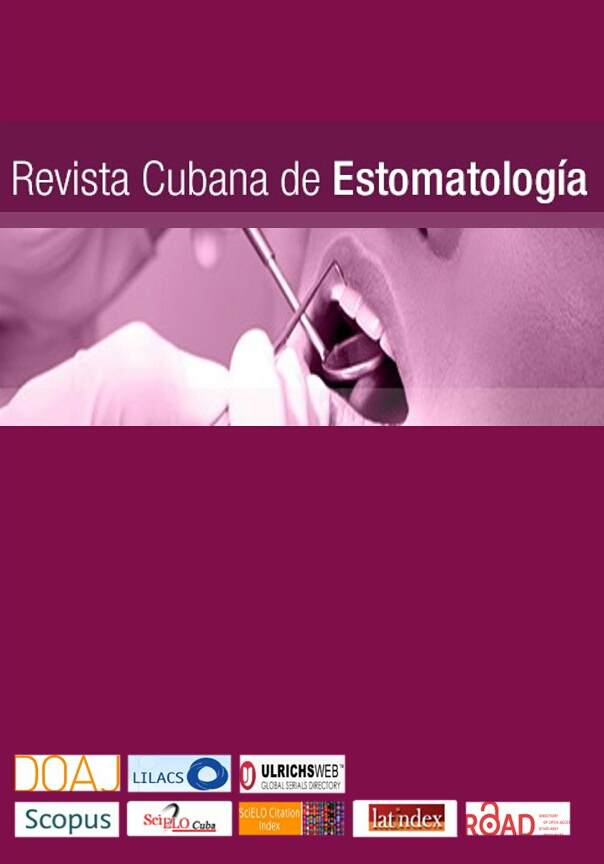Therapeutic approach to atypical Le Fort I fracture
Keywords:
skull fractures, fracture fixation, traumatology.Abstract
Objective: Describe the clinical management of an atypical Le Fort I fracture case.
Case presentation: A 33-year-old patient was brought to the Surgical and Maxillofacial Traumatology Service of Humberto Lucena Senatorial Emergency and Trauma Hospital in Joao Pessoa (PB), Brazil, after undergoing physical aggression. The patient was conscious and lucid. Clinical examination revealed sinking of the middle third of the face with edema and bilateral periorbital ecchymosis. Visual acuity and ocular motricity were preserved in both eyes. A cut-contusion injury on the upper lip, maxillary mobility when handled and discrete occlusal dystopia were also observed. Imaging examination identified a high bilateral Le Fort I fracture. The therapeutic approach chosen was fracture reduction and fixation with plates and screws. After a period of two months, the patient is healing well without any apparent functional or aesthetic alteration.
Conclusions: Atypical Le Fort I fractures are not frequent; however, a number of etiologies besides the impact force may bring about them. Treatment should be based on the one for classical Le Fort I fractures with adjustments to the surgical access approach.
Downloads
References
Ali K, Lettieri SC. Management of panfacial fracture. Semin Plast Surg. 2017;31(2):108-17.
Bezerra ALD, Ribeiro RC, Sousa MNA, Alves AN, Pereira OHG, Sobreira T. Epidemiological profile of facial trauma. Rev Enferm UFPI. 2017;6(2):57-64.
Foresta E, Torroni A, Gasparini G, Saponaro G, Longo G, Boniello R, et al. Use of n-butyl-2-cyanoacrylate (glubran2) in fractures of orbital-maxillo-zygomatic complex. J Maxillofac Oral Surg. 2015;14(3):761-4.
Garg RK, Alsheik NH, Afifi AH, Gentry LR. Pterygoid plate fractures: not limited to Le Fort fractures. J Craniofac Surg. 2015;26(6):1823-5.
Janovic A, Milovanovic P, Hahn M, Rakoceviv Z, Amling M, Busse B, et al. Association between regional heterogeneity in the mid‐facial bone micro‐architecture and increased fragility along Le Fort lines. Dent Traumatol. 2017;33(4):300-6.
Ji SY, Kim SS, Kim MH, Yang WS. Surgical methods of zygomaticomaxillary complex fracture. Arch Craniofac Surg. 2016;17(4):206-10.
Kim HS, Kim SE, Lee HT. Management of Le Fort I fracture. Arch Craniofac Surg. 2017;18(1):5-8.
Lucena FS, Hissano WS, Sant’Ana E. Atendimento ao paciente politraumatizado facial. Pet Informa. 2014;26(1):1-4.
Mast G, Ehrenfeld M, Cornelius CP, Litshcel R, Tasman AJ. Maxillofacial Fractures: Midface and Internal Orbit —Part I: Classification and Assessment. Facial Plast Surg. 2015;31(4):351-6.
Ogura I, Kawashima Y, Muramatsu T, Ito K, Kaneda T. Characteristic computed tomographic findings of midface fractures relative to the cause of injury: a fall or violence. Oral Radiol. 2015;31(3):149-54.
Oliveira-Campos GH, Lauriti L, Yamamoto MK, Junior RC, Luz JGC. Trends in Le Fort fractures at a south American trauma care center: characteristics and management. J Maxillofac Oral Surg. 2016;15(1):32-7.
Ravikumar G, Manoharan SGR. A study on faciomaxillary injuries in a tertiary care hospital. Int Surg. 2017;4(8):2450-4.
Regmi KP, Tu J, Ge S, Hou C, Hu X, Li S, et al. Retrospective clinical study of maxillary sagittal fractures: predictors of postoperative outcome. J Oral Maxillofac Surg. 2017;75(3):576-83.
Roumeliotis G, Ahluwalia R, Jenkyn T, Yazdani A. The Le Fort system revisited: trauma velocity predicts the path of Le Fort I fractures through the lateral buttress. Plast Surg. 2015;23(1):40-2.
Sukegawa S, Kanno T, Katase N, Matsuzaki H, Shibata A, Takahashi Y, et al. A massive osteonecrosis with Le Fort I-type pathological fracture, caused by bisphosphonate-related osteonecrosis of the jaw (BRONJ): A rare case report. J Oral Maxillofac Surg Med Pathol. 2016;28(3):255-8.
Published
How to Cite
Issue
Section
License
Authors retain all rights to their works, which they can reproduce and distribute as long as they cite the primary source of publication.
The Rev Cubana Estomatol is subject to the Creative Commons Attribution-Non-Commercial 4.0 International License (CC BY-NC 4.0) and follows the publication model of SciELO Publishing Schema (SciELO PS) for publication in XML format.
You are free to:
- Share — copy and redistribute the material in any medium or format.
- Adapt — remix, transform, and build upon the material.
The licensor cannot revoke these freedoms as long as you follow the license terms.
Under the following terms:
Attribution — You must give appropriate credit, provide a link to the license, and indicate if changes were made. You may do so in any reasonable manner, but not in any way that suggests the licensor endorses you or your use.
- NonCommercial — You may not use the material for commercial purposes.
No additional restrictions — You may not apply legal terms or technological measures that legally restrict others from doing anything the license permits.
Notices:
- You do not have to comply with the license for elements of the material in the public domain or where your use is permitted by an applicable exception or limitation.
- No warranties are given. The license may not give you all of the permissions necessary for your intended use. For example, other rights such as publicity, privacy, or moral rights may limit how you use the material.


